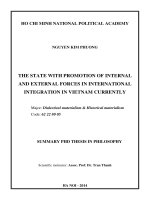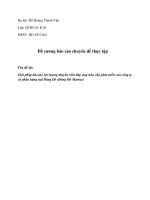- Trang chủ >>
- Lớp 6 >>
- Giáo dục công dân
Xu hướng dạy tiếng Anh đáp ứng nhu cầu giao tiếp nơi công sở trên thế giới: Một số khuyến nghị cho Việt Nam
Bạn đang xem bản rút gọn của tài liệu. Xem và tải ngay bản đầy đủ của tài liệu tại đây (340.3 KB, 6 trang )
<span class='text_page_counter'>(1)</span><div class='page_container' data-page=1>
<b>1. INTRODUCTION</b>
It is universally accepted that nowadays English
serves as an important tool for people to enhance
knowledge via huge sources of information;
facilitate successful career; and satisfy the needs
to travel and to explore different cultures in the
world. Thus, universities in Vietnam have placed
strong emphasis on improving English proficiency
for students to participate in global labor
market. To equip students with future job skills,
Vietnamese curricula in English normally focus
on formal presentation, email writing, negotiation
skills, telephoning skills, etc. However, recent
<b>PHẠM THỊ TỐ LOAN*</b>
*<sub>Đại học Thương Mại , ✉</sub>
<i>Ngày nhận bài: 24/8/2017; ngày hoàn thiện: 12/10/2017; ngày duyệt đăng: 15/11/2017</i>
XU HƯỚNG DẠY TIẾNG ANH ĐÁP ỨNG
NHU CẦU GIAO TIẾP NƠI CÔNG SỞ
TRÊN THẾ GIỚI: MỘT SỐ KHUYẾN NGHỊ
CHO VIỆT NAM
<b>TÓM TẮT</b>
Trong thời đại ngày nay, tiếng Anh là một công cụ đắc lực giúp con người nâng cao trình độ,
trao đổi hợp tác với đồng nghiệp trên phạm vi toàn cầu và mang đến cơ hội thành cơng trong sự
nghiệp. Vì vậy, các trường đại học ở Việt Nam đã luôn nỗ lực và chú trọng nâng cao kỹ năng tiếng
Anh cho sinh viên với mong muốn đáp ứng yêu cầu của thị trường lao động trong thời kỳ hội
nhập. Tuy nhiên, chương trình và phương pháp dạy tiếng Anh hiện tại vẫn cịn nhiều bất cập. Do
đó, bài báo này sẽ cung cấp thông tin từ các nghiên cứu gần đây nhất về xu hướng dạy tiếng Anh
đáp ứng nhu cầu giao tiếp trong công việc trên thế giới; trình bày thực trạng dạy và học tiếng Anh
ở Việt Nam, từ đó đưa ra các khuyến nghị cho các trường đại học ở Việt Nam nhằm nâng cao kỹ
năng tiếng Anh giao tiếp nơi công sở cho sinh viên.
<b>Từ khóa: </b><i>tiếng Anh cơng sở, tồn cầu hóa, nhu cầu, đại học, giao tiếp</i>
</div>
<span class='text_page_counter'>(2)</span><div class='page_container' data-page=2>
they can communicate with those who do not share
their first language and culture. As such, learning
workplace English in an integrated world requires
both teachers and students to make changes in
response to international trends so that our students
will confidently become global citizens and
participate in the world’s labor market. This article
is intended to present the world’s latest trends in
recent studies on teaching and learning English at
workplace contexts, then some recommendations
are put forth for Vietnamese context.
<b>2. REVIEW OF LITERATURE</b>
<b>2.1. Needs analysis in English language </b>
<b>teaching</b>
Needs analysis is used to identify and evaluate
the needs of a target group, thereby make the
right decision in human services and education
(Mc Killip, 1987). In this process, it highlights
the relevance of the existing problems and the
solutions to improve the situation. Brown (1995)
also states that need analysis can be used to collect
and analyze necessary information to meet the
language learning requirements of the students in
a particular learning context. Apparently, needs
analysis in English language teaching plays a
vital role since knowing about students’ needs
is one of the best ways to help them improve
their target language. As a result, it is necessary
to be aware of learners’ needs when designing
courses and lesson objectives (Long, 2005). For
instance, learners’ need vary greatly for students
from various disciplines such as information
technology, business, tourism, etc. Obviously,
each group requires English for different skills and
lexicons. When needs are identified, it is described
in terms of goals and objectives which serve as the
foundation to design teaching activities, materials
and tests (Iwai, 1999). Thus, needs analysis helps
students become engaged in the lesson as they will
be motivated to learn the language that is relevant
to their needs.
<b>2.2. English usages to meet the needs of </b>
<b>communication at work </b>
Apparently, globalization has brought about
significant changes in business, industry and other
professions in the 21st<sub> century. The noticeable </sub>
changes include: interdependency of economies
among different countries, international
outsourcing, increased immigrant workers,
worldwide collaboration in developing products
and services. According to Groddol (2006), to
make successful collaboration at a world scale,
people often use English as a lingua franca (a
common language between speakers whose
native languages are different). For this reason,
many studies have been conducted to investigate
the needs of using English at workplace and the
necessary English skills in the 21st<sub> Century.</sub>
Regarding the needs of using English at work,
employers are in favor of staff with high English
proficiency as English is the common language
used in international business. Employees
in multinational companies are expected to
communicate in English with clients and
colleagues from different countries in the world.
Pinon and Haydon (2010) state that high English
level enables a nation’s labor force to participate
successfully in the world market and attracts
more foreign investment. Grin (2010) affirms that
employees proficient in English are inclined to
have 12% higher income in comparison with those
who are not.
In addition, the rapid development of
technology implies that apart from expertise, it is
necessary for the workforce to equip themselves
with skills and knowledge to solve various
tasks in their jobs. These skills include problem
solving, effective communication, teamwork
skills, technological skills, creativity, and critical
thinking. Due to the fact that English is the common
language of communication worldwide, students
are expected to apply the above-mentioned skills
in English in their future job.
</div>
<span class='text_page_counter'>(3)</span><div class='page_container' data-page=3>
era is not a separate subject at school and it is
necessary to combine English with other skills
in order to meet the needs of careers in the 21st
century. Employees use English to communicate
and collaborate with customers and colleagues;
organize and analyze information; make decision;
update new technology; explore cultures and
develop themselves. Recently, theory about the use
of English at workplace communication has been
added a new skill: intercultural communication.
Globalization trend has created opportunities
to communicate and exchange information
among different cultures; therefore, intercultural
communication has become an indispensable part
of contemporary society. Cultural barriers from
different places in the world will be eliminated
and collaboration will be nurtured with the use of
English and intercultural awareness.
Moreover, researchers posit that English
should be accompanied by technological skills. It
is important for people to combine these two skills
in order to communicate in a world that the borders
between the real and the virtual, and the distances
in space are gradually blurred (Collier, 2007).
In fact, apart from face-to-face communication,
modern technology has made it possible to have
meeting via Skype, video conferencing, blogs, etc.
Thus, with these new forms of communication,
educators are required to update English curricula
and teaching methods in response to the demand
of future jobs.
In short, English language teaching in the
new era not only focuses on language skills but
it also requires sets of other skills to facilitate
communication in future jobs. Policy makers,
curriculum and material designers, teachers, and
administrators in Vietnam should take these needs
into account to equip students with confidence and
competences in their future jobs.
<b>3. THE CASE OF TEACHING AND </b>
<b>LEARNING ENGLISH IN VIETNAM TO </b>
<b>MEET THE NEED OF WORKPLACE </b>
<b>3.1. The current situation of English </b>
<b>teaching in Vietnam</b>
</div>
<span class='text_page_counter'>(4)</span><div class='page_container' data-page=4>
<b>3.2. Graduate students’ English level in </b>
<b>Vietnam</b>
As there are many problems in teaching and
learning English, graduate students’ English level
are said to be substandard which makes Vietnamese
workers less competitive in the international
market (Duong, 2013).
In the first place, the most common complaint
of employers is concerned with limited English
capability in understanding and expressing their
ideas in English in job interviews. As stated by
employers, many students have good knowledge
of their profession; however, due to low English
proficiency, they miss the chance to get accepted
to the company. In fact, what employers seek from
applicants are professional knowledge, English
language, IT and other soft skills (Duong, 2013)
Furthermore, once accepted to a company,
a number of students are unable to approach
international high-quality training due to their
low English proficiency. These training sessions
are usually conducted in English with the aims of
updating new trends, knowledge and expertise.
Those who are bad at English deprive themselves
of the possibilities to go abroad, broaden their
mind, and develop professionally (Nguyen, 2010).
Finally, as university syllabuses rarely offer
opportunities for students to communicate in
English involving different linguistic and cultural
backgrounds, graduate students lack confidence
in expressing themselves with overseas clients
and foreign colleagues. In the globalization era
where people use English as a common language
for communication with the outside world, people
with English incompetence will be left behind
(Hoang, 2008).
In short, the quality of teaching and learning
English at Vietnamese universities and the
substandard English proficiency of graduate
students indicate that there is a gap between the
real needs of the market and university training
programs. Thus, policy makers, curriculum
developers, administrators, and teachers should
pay adequate attention to the quality of English
teaching to meet the demand of workplace
communication.
<b>4. SOME RECOMMENDATIONS FOR </b>
<b>UNIVERSITIES IN VIETNAM</b>
From the trends of the English usages at
workplace communication in the globalization
era, and the status quo of teaching English at
Vietnamese universities, the article will propose
some suggestions to design curricula, teaching
materials and methodologies to meet the
requirements of 21st<sub> century careers.</sub>
<i>In the first place,</i> English curricula should
take job skills into account. After graduation, it is
likely that many students will work for national
or multinational companies in Vietnam. Students
will be required to use English in accordance with
their majors from different aspects such as law,
economics, tourism and hospitality, etc. Thus,
instead of merely focusing on vocabulary, grammar,
reading and translation skills, it is necessary to teach
English skills which meet the needs of students’
future jobs. To this end, universities should apply
English medium instruction (EMI) programs to
teach courses like law, economics, tourism, etc.
in English to enhance students’ language ability
and their expertise at the same time. Besides,
project-based learning is an effective approach
which assists students to practice English and
job skills in the real workplace situations. For
example, in Business English, project-based tasks
like exchanging e-mails in English to respond
to business partners’ requests, team meeting via
Skype or video conferencing with colleagues from
different countries to discuss business strategies,
etc. will strengthen students’ confidence in using
English in their later working lives.
<i>In addition</i>, intercultural communication is a
</div>
<span class='text_page_counter'>(5)</span><div class='page_container' data-page=5>
knowledge alone are no longer sufficient for
successful communication. However, it is likely
that few English teachers have rich knowledge
and experience of the diversity of multicultural
workplace situations (Hoang, 2008). Therefore,
teachers should take advantage of the Internet,
YouTube, newspapers, and magazines as authentic
materials to get students familiarized with
real-world situations. Besides, another practical method
employed by America and European countries is
the exchange programs in which domestic students
have internships abroad with a view to gaining
real experience in different cultures. Students
spend three to twelve months in another country
to improve English and enhance knowledge about
economics, society and culture of the nation.
<i>Moreover,</i> as previously mentioned, teamwork
and collaboration skills play a vital role in today’s
workplace; however, there are few chances
for students to practice in pair work and group
work due to big class size. It is therefore worth
maximizing communication by reducing the
number of students in English class and changing
the class setting. Small class size gives all students
the opportunities to perform in front of class
and receive detailed feedback from teachers. In
addition, class seating arrangement like U-shape
and cluster seating (students seat in groups) should
replace traditional rows to facilitate interaction
among members in class.
<i>Besides,</i> it is also noticeable that the omission
of oral test in mid-term and end-of-term test of
non-English major students leads to their demotivation
in improving speaking skill. Thus, university
administrators should incorporate speaking skill in
these two tests. When students frequently practice
speaking for the test, they can enhance their
English competence which in turn helps them gain
confidence at workplace communication.
<i>Finally</i>, it is apparent that teachers are the
agents of changes in English curricula to respond
to the needs of teaching and learning English at
workplace communication. Therefore, special
training programs as well as in-service teacher
professional development. Both programs should
necessarily update current trends in learning and
teaching English for job skills.
<b>5. CONCLUSION</b>
There is a tendency that English for
communication at workplace nowadays no longer
focuses on how to write a formal email, make
a formal presentation or conduct a successful
negotiation. A global citizen is expected to use
English effectively in informal situations and
apply different skills such as teamwork skills,
technological skills, intercultural communication,
etc. to establish and maintain relationships with
colleagues and clients globally. Hence, universities
in Vietnam should keep up with this trend to
develop courses and syllabuses in response to the
rigorous demand of today’s international labor
market. By doing so, Vietnamese students will
definitely have English competence and expertise
to work on a global scale./.
<b>References:</b>
1. Dương Thị Anh (2013), <i>Nghiên cứu đánh giá </i>
<i>năng lực nghe tiếng Anh của sinh viên khối ngành </i>
<i>không chuyên </i>(Nghiên cứu trường hợp Đại học
Phương Đông), Luận văn thạc sỹ, Đại học Quốc
gia Hà Nội, Viện Đảm bảo chất lượng giáo dục.
2. Nguyễn Thị Hoàng Báu (2010), <i>Nâng cao </i>
<i>năng lực giao tiếp cho sinh viên tiếng Anh thương </i>
<i>mại năm II</i>:<i> Nhu cầu và khuyến nghị</i>. Retrieved
from < />tbGHP1/08.4.r.Hoang%20Bau-T.pdf>.
3. Đỗ Thị Xuân Dung, Cái Ngọc Duy Anh
(2010), “Dạy và học tiếng Anh chuyên ngành trong
tình hình mới: Thách thức và giải pháp”. Tạp chí
<i>Khoa học, </i>Đại học Huế, số 60, tr.31-41.
</div>
<span class='text_page_counter'>(6)</span><div class='page_container' data-page=6>
<i>nhập khu vực và tồn cầu hóa</i>, Đề tài trọng điểm
cấp đại học Quốc gia, Đại học Quốc gia Hà Nội.
5. Brown JD. (1995),<i> The elements of language </i>
<i>curriculum: A systematic approach to program </i>
<i>development</i>. Heinle and Heinle.
6. Clagett C. A. (1997), <i>Workforce skills </i>
<i>needed by todays’ employers. Market Analysis.</i>
Largo, MD: Prince George’s community College,
Office of Institutional research analysis. Clark.
7. Collier L. (2007), <i>The shift to 21st</i>
<i>century literacies</i>. The Council Chronicle,
4-8, Accessed on August 18th<sub> 2017, </sub>
Retrieved from < />The+Shift+to+21st+Century+Literacies.pdf>.
8. Forey G. & Nunan, D. (2002), “The role
of language and culture within the accountancy
workplace”. In C. Barron, N. Bruce & D. Nunan.
<i>Knowledge and discourse: Towards an ecology of </i>
<i>language, </i>pp 204-216. Pearson.
9. Graddol D. (2006), English next: <i>Why global </i>
<i>English may mean the end of English as a foreign </i>
<i>language.</i> British Council.
10. Grin F. (2010), “English as economic
value: Facts and fallacies”, <i>World Englishes, </i>
20(1)<i>,</i> pp.65-78.
11. Iwai T., Kondo K., Lim D., Ray G., Shimizu
H. & Brown J. D. (1999), <i>Japanese language needs </i>
<i>analysis.</i> National Language Resource Center.
12. Long M. (2005), <i>Second language needs </i>
<i>analysis</i>. Cambridge University Press.
13. McKillip J. (1987), Need Analysis: Tools
for the Human Service and Education. <i>Applied </i>
<i>Social Research Methods Series, </i>Volume 10. Sage
Publications.
14. Pinon R. & Haydon J (2010), <i>The benefits of </i>
<i>the English language for individuals and societies: </i>
<i>Quantitative indicators from Cameroon, Nigeria, </i>
<i>Rwanda, Bangladesh and Pakistan</i>. Euromonitor
International.
15.< />
education/159027/poor-english-skills-challenge-vietnamese-students.html>, truy cập ngày 19-8-2017.
<b>GLOBAL TRENDS IN TEACHING ENGLISH TO MEET THE NEEDS</b>
<b> OF WORKPLACE COMMUNICATION: RECOMMENDATIONS </b>
<b>FOR VIETNAMESE CONTEXT</b>
<b>PHAM THI TO LOAN</b>
<b>Abstract: Nowadays, English serves as an important tool for people to enhance their knowledge, </b>
communicate with colleagues worldwide, and achieve success in their career. Thus, Vietnamese
universities have made a lot of efforts to increase students’ English proficiency with the purpose of
meeting the needs of labor market on a global scale. However, curricula and methods in teaching
English are still unsatisfactory and many changes should be made. This article is intended to
present findings from recent research concerning trends in teaching English skills to meet the
needs of workplace communication, discuss the current situation of teaching English in Vietnam,
then put forward some recommendations for Vietnamese universities to improve student’s English
communication at work.
</div>
<!--links-->









